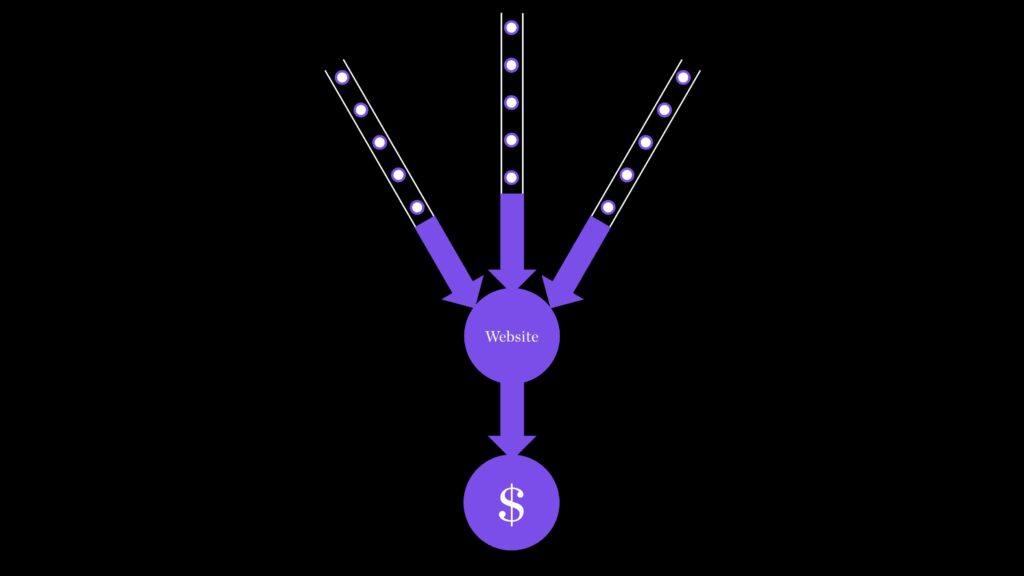Article last updated on January 28, 2023
Do you want to know how to increase customer lifetime value? Well, here we’ll take a look at some strategies for doing just that.
Maximizing customer lifetime value by only 5% increases profits anywhere from 25–95%. That’s quite an incentive! So let’s dive in and explore some powerful strategies for boosting customer lifetime value.

In this article, we’ll discuss different approaches businesses are taking to up their game when it comes to retaining existing customers.
We’ll explore tools like reward programs, cross-selling, loyalty incentives, and more—all designed to help keep customers engaged and maximize long-term profitability.
Consider This Before You Focus on Increasing CLV
Before you start implementing strategies to increase customer lifetime value, it’s important to consider a few things.
- Make sure you have a clear understanding of who your customers are and what their needs are. Knowing this information will help you create targeted campaigns that will be more effective at increasing CLV.
- Take the time to analyze your current customer data. This will give you an idea of where your customers are coming from and how long they stay with you. It can also help identify areas for improvement or potential opportunities for growth.
- Set realistic goals for yourself and your team when it comes to increasing CLV. Don’t expect overnight success – focus on small wins that add up over time and measure progress along the way.
I can tell you from personal experience working as a growth strategist that most businesses try to run before they can walk.
Be laser-focused on your core customer base, and don’t try to do too much too soon.
Now, let’s take a look at some strategies for increasing customer lifetime value.
Strategies to Increase Customer Lifetime Value
There are many ways to increase customer lifetime value. It depends on what kind of business you have, what your goals are, and how much effort you’re willing to put in.
But I want to share with you some of the most effective strategies that have been proven to work.
1. Cross-sell and upsell

Cross-selling and upselling are incredibly powerful ways to increase customer lifetime value.
By introducing customers to new product offerings, you can encourage them to purchase more items during the same visit than they otherwise would have.
This not only increases your sales revenue but also gives you an opportunity to build a stronger relationship with each customer.
What’s even better is that when done right, cross-selling and upselling don’t feel like typical marketing tactics; they actually enhance the experience of shopping by helping people find what they’re looking for faster or discover products they didn’t realize were available.
This can lead to higher average purchases, as well as repeat visits from customers who appreciate the personalized recommendations provided by your business.
By engaging with customers in this way, you create trust, which boosts loyalty and strengthens relationships.
You’ll be able to keep customers coming back time after time while increasing their lifetime value—all without spending additional money on expensive ads or promotions. And that’s something any business owner should consider doing if they want to make sure their profits stay healthy over the long haul.
Offering loyalty or rewards programs provides another important incentive that helps businesses retain existing customers while also encouraging them to spend more often and at higher amounts.
2. Offer loyalty or rewards programs

As the name suggests, these programs reward loyal customers with perks for their continued patronage of a business.
Businesses can encourage customers to buy from them again by giving them extra discounts or special deals on certain products and services.
Rewards points and discounts are an effective way to build relationships with existing customers in order to encourage them to become long-term patrons of your business.
Loyalty programs also help businesses retain customers over time because they provide an incentive for people to continue using the same product or service rather than switching providers.
Additionally, loyalty programs provide valuable insights into consumer behavior, which allows businesses to better understand how their target audience interacts with their products and services.
By leveraging this data, companies can customize their offerings according to what resonates most with consumers and create more personalized experiences tailored specifically towards each user’s needs.
3. Personalize communication and marketing

When it comes to increasing customer lifetime value, personalized communication and marketing are powerful tools.
It allows businesses to build meaningful relationships with their customers in order to foster loyalty and increase sales.
For instance, email marketing has become an increasingly popular way of connecting with customers. Businesses can use this channel to send out tailored messages that are engaging and informative—something that will provide added incentive for customers to purchase from them again.
Furthermore, utilizing social media channels such as Facebook or Instagram also helps companies create stronger connections with their target audience through regular interaction and content sharing.
By combining the power of personalization with these modern digital approaches, businesses have the opportunity to create long-lasting customer relationships that can be invaluable when it comes to improving customer lifetime value.
Moreover, following up on every transaction or query with follow-up emails and messages provides another layer of engagement that shows customers they’re valued by your business.
This not only strengthens trust between both parties but also drives further conversions over time.
Therefore, it’s important for businesses to focus on developing personalized strategies if they want to maximize customer lifetime value—because after all, building strong relationships is key!
4. Utilize email and digital communication

What makes email campaigns effective is their personalization potential. With emails, you can create custom messages tailored for each customer’s individual needs—and that often leads to increased loyalty and trust.
Here are three strategies for leveraging email and digital communications to grow your business:
- Develop highly personalized content based on insights about your customers – Knowing who your target audience is and crafting content specifically designed for them will always lead to more conversions than generic marketing copy.
- Monitor user engagement levels – By tracking how customers interact with your content, you can identify trends in consumption patterns as well as areas of improvement.
- Utilize A/B testing regularly – This allows you to compare two versions of a message or website page and determine which one drives better results.
These tactics don’t just help you cultivate deeper relationships with current customers; they also allow you to reach out effectively to prospective ones too!
And if done right, they’ll make it easier for you to identify and target high-value customers who hold the key to unlocking greater success for your business.
5. Identify and target high-value customers

Identifying and targeting high-value customers—those who are likely to have a longer lifetime value for your company – should always be at the forefront of any strategy when attempting to increase customer lifetime value.
After all, if you nurture the right relationships with these key players in the customer journey, they will remain loyal to your brand long after others may have moved on.
The power of identifying and targeting high-value customers lies in the ability to tailor marketing efforts specifically towards them.
By engaging with these customers more frequently than other types of consumers, it allows businesses to create a personalized experience for their most valuable assets.
Furthermore, this type of targeted approach could also make these customers feel special and appreciated, an invaluable factor when trying to retain loyalty over time.
This kind of strategic thinking has become essential in today’s fast-paced world as companies look for ways not only to keep up but to stand out from their competition.
It enables businesses to really hone in on what matters most: making sure existing customers receive excellent service while gaining new ones that bring even greater returns down the line.
6. Encourage customer referrals

When someone refers a friend, they are showing that they believe in what you’ve created enough to recommend it to others.
That kind of customer loyalty isn’t built overnight – it requires genuine satisfaction with the products or services you offer.
If this level of commitment from customers exists, then referrals will follow naturally and lead to increased revenue over time as well as improved customer retention rates.
The key here is creating a great experience so customers feel confident in referring their peers. An exceptional product plus excellent customer service results in satisfied users who become loyal ambassadors for your brand through word-of-mouth advertising.
In turn, these advocates help boost sales, which gives you even more data points to analyze user feedback and further improve the customer experience—thereby increasing the overall customer lifetime value!
7. Gather customer feedback

When done right, gathering customer feedback can have a truly transformative effect on your business. It not only helps build relationships with existing customers but can also be used to target new potential customers.
At its core, collecting customer feedback involves understanding what drives your customers’ needs and interests—from their perspective rather than yours.
This means more meaningful interactions with customers that get you closer to them as well as better decision-making when it comes to product development and marketing strategies.
One way of doing this is by creating a customer advisory board, which gives your customers the opportunity to provide insights directly into how you should shape future products or services.
This kind of direct interaction between consumers and businesses creates an environment where people feel heard and respected—something every customer needs in order to remain loyal over time.
In addition, actively seeking out customer feedback through surveys or polls allows businesses to understand what resonates best within their target audiences while identifying areas that need improvement down the line.
By doing these things, companies can make sure they stay ahead of the curve when it comes to meeting customer expectations and giving them relevant solutions that help increase their lifetime value.
8. Offer a subscription or membership model

Ah, the subscription or membership model. The magical solution for companies looking to increase customer lifetime value without lifting a finger!
After all, why waste time and energy on your customers when you can simply offer them the option to subscribe?
It’s such an easy way out of doing any real work—and best of all, it gets more money coming in each month!
But wait—there may be more to this story than meets the eye. While subscriptions are certainly one strategy that companies can use to keep their customers around longer and boost lifetime value, they don’t always work as well as we’d like them to.
Sure, offering memberships or subscriptions might bring in more revenue initially, but it won’t necessarily create loyalty or trust between the customer and the business.
To really drive customer lifetime value up over time, businesses need to go beyond simply offering payment plans—they need to build relationships with their customers by providing valuable services and creating a sense of community.
9. Create a sense of community

Using social media platforms can be a powerful tool for building this sense of community. With their reach and incredible personalization capabilities, businesses have unprecedented access to customers worldwide.
By offering interactive forums where customers can ask questions, receive advice from others, or share stories with each other, companies create an environment that encourages engagement and loyalty.
This allows customers to not only feel connected to your brand but also become part of something larger than themselves.
Companies should take advantage of these opportunities by engaging with customers online through comments on posts or answers to queries about products/services.
Moreover, they should ensure content posted on these platforms is relevant and valuable; this boosts trust between the company and its customers as well as creates more meaningful interactions, which will encourage repeat visits over time.
By implementing strategies such as these, companies are able to build stronger bonds with their customer base while providing them with valuable experiences that keep them coming back again and again—all of which leads to increased lifetime value for both parties involved.
10. Create valuable content

Content is a powerful tool for engaging customers and increasing customer lifetime value. Here are three ways to leverage content as part of your marketing strategy:
- Invest in creating valuable content such as blog posts, podcasts, or video series related to topics relevant to your target market. This type of content helps build trust with potential customers by providing them with access to industry-leading advice from thought leaders within your business – all without requiring any commitment from them yet.
- Use social media platforms like Twitter, TikTok, Instagram, and Facebook to promote your content and reach new audiences. You can also run paid advertising campaigns on these platforms to get more potential customers to see your business and interact with it.
- Make sure you provide excellent customer service when responding to questions or comments posted on your website or social media pages – this will help establish brand loyalty among existing customers and encourage word-of-mouth referrals from satisfied individuals.
Content creation should be seen as an investment in building relationships with current and future customers rather than just another cost associated with running a business.
When done correctly, it’s one of the most effective strategies available for boosting customer lifetime value through meaningful interaction and support over time. The next step? Investing in retargeting ads for even more success!
11. Invest in retargeting ads

Retargeting advertisements are an efficient way of delivering relevant messages to potential customers who have already interacted with your brand or website.
By targeting these individuals again through remarketing campaigns, you can increase their likelihood of making a purchase and boost their loyalty towards your business.
These types of ads also provide an opportunity to encourage repeat purchases from existing customers, which will help maximize their lifetime value.
If done correctly, targeted ad campaigns can be very effective in raising awareness about your products and services among new audiences as well as engaging existing customers more deeply with your brand.
They also give you the ability to monitor and measure results, so you can adjust tactics accordingly and optimize performance over time. Additionally, they enable you to test different creative approaches, such as offering discounts or free shipping promotions, to gauge what works best for each individual user journey.
In short, investing in retargeting ads is one of the most powerful ways to engage current customers while expanding reach into new markets—two key factors when it comes to driving up customer lifetime value!
Frequently Asked Questions
After reading this article, you may still have some questions about how to increase customer lifetime value. Here are a few of the most common questions we hear:
What are the most cost-effective strategies to increase customer lifetime value?
Investing in content creation, using social media platforms, giving great customer service, and investing in retargeting ads are the most cost-effective ways to increase the lifetime value of a customer.
The reason why these strategies are so cost-effective is that they require minimal upfront investment and can be scaled up or down depending on the size of your business. Also, they give you a chance to keep in touch with customers over time and build relationships that will last for years.
How can I use customer lifetime value to inform my marketing strategies?
As any experienced marketer knows, understanding customers’ preferences helps businesses develop effective tactics for keeping them around longer – which is why using customer lifetime value to inform marketing strategies is so important.
Let me break down how CLV informs your strategy with these five points:
1. With customer lifetime value, you have valuable insights into what will make each person feel valued and appreciated as a customer.
2. You can use this data to craft timely offers, rewards, or even discounts tailored specifically to their needs.
3. You also learn when customers are most likely to leave, so you can reach out to them before they decide to go.
4. Knowing how long people stay engaged with your brand gives you a better idea of where to best allocate resources for maximum return on investment (ROI).
5. Lastly, customer lifetime value provides a comprehensive view of the journey from purchase through loyalty – making it easier for marketers to create memorable experiences that keep customers coming back again and again.
Using CLV in marketing strategies isn’t just smart business; it’s also essential if you want to ensure longevity and success in today’s rapidly evolving marketplace. From identifying potential opportunities and trends quickly, allocating budgets more effectively and creating personalized experiences, there really is no limit when it comes to leveraging CLV as part of your overall strategic plan. So don’t wait another minute—start taking advantage of this invaluable tool now!
Are there any risks associated with increasing customer lifetime value?
The first risk is relying too much on traditional thinking when trying to increase customer lifetime value. If your efforts focus solely on sales discounts and promotions without considering more creative options, then you could be missing out on opportunities to add real value for customers in ways that will keep them coming back long-term. This can lead to short-sighted strategies that don’t contribute enough to the bottom line over time.
On the other hand, if you put too much emphasis on maximizing customer lifetime value at all costs, regardless of whether or not it adds actual value to customers – then you may end up alienating them instead of building relationships and loyalty. You have to strike a balance between offering attractive deals while also providing true added benefits that create an emotional connection between customers and your brand.
That’s why smart marketers take a holistic approach when looking for ways to increase customer lifetime value. They look beyond just discounts and marketing campaigns; they craft customized experiences tailored specifically for their most loyal customers that build genuine trust through meaningful interactions over time. That’s what truly drives lasting engagement and keeps people coming back again and again.
It’s important to remember that increasing customer lifetime value does come with some inherent risks, but these can be managed with careful thoughtfulness and planning as well as ongoing oversight throughout the process. As long as you watch out for possible pitfalls, investing in strategies to increase customer lifetime value can pay off big in terms of getting more money from existing customers and bringing in new ones.
How can I leverage technology to increase CLV?
You can use AI-powered chatbots to provide 24/7 customer service and quickly answer questions or address concerns. You can also use predictive analytics to identify potential opportunities and trends in customer behavior, allowing you to tailor your marketing campaigns more effectively. You can also use data-driven insights to make targeted offers that are tailored to the needs and interests of each individual customer.
By leveraging technology, you can also automate processes such as order tracking and delivery notifications so that customers always know where their orders are in real time.
This helps build trust and loyalty, which in turn can lead to increased customer lifetime value. Additionally, you can use technology to create personalized experiences for customers that make them feel valued and appreciated. This could include things like automated emails with special offers or discounts based on their past purchases.
Conclusion
Knowing how to increase customer lifetime value is essential for any business that wants to stay competitive in today’s market.
By taking a whole-business approach and focusing on creating experiences that are meaningful and fit the needs of each customer, you can build relationships that will last and bring in more money over time.
Building strong relationships with your customers and investing in experiences for them, such as loyalty programs and personalization—even simple things like sending thank-you cards or offering discounts on repeat purchases—will help nurture those connections and keep people coming back.
Of course, there are risks associated with increasing customer lifetime value, but if done correctly, these strategies can pay off tenfold.
After all, happy customers who trust your brand are far more likely to stay loyal and spread the word than someone who had a bad experience once.
By taking steps to build relationships with your customers through thoughtful outreach, you’ll be able to track changes in their lifetime value over time and ensure long-term success for your business.


